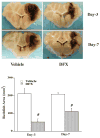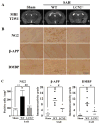Diffusion tensor imaging in hemorrhagic stroke
- PMID: 26015333
- PMCID: PMC4631675
- DOI: 10.1016/j.expneurol.2015.05.011
Diffusion tensor imaging in hemorrhagic stroke
Abstract
Diffusion tensor imaging (DTI) has evolved considerably over the last decade to now be knocking on the doors of wider clinical applications. There have been several efforts over the last decade to seek valuable and reliable application of DTI in different neurological disorders. The role of DTI in predicting outcomes in patients with brain tumors has been extensively studied and has become a fairly established clinical tool in this scenario. More recently DTI has been applied in mild traumatic brain injury to predict clinical outcomes based on DTI of the white matter tracts. The resolution of white matter fiber tractography based on DTI has improved over the years with increased magnet strength and better tractography post-processing. The role of DTI in hemorrhagic stroke has been studied preliminarily in the scientific literature. There is some evidence that DTI may be efficacious in predicting outcomes of motor function in animal models of intracranial hemorrhage. Only a handful of studies of DTI have been performed in subarachnoid hemorrhage or intraventricular hemorrhage scenarios. In this manuscript we will review the evolution of DTI, the existing evidence for its role in hemorrhagic stroke and discuss possible application of this non-invasive evaluation technique of human cerebral white matter tracts in the future.
Keywords: Cerebral hemorrhage; Diffusion tensor imaging; Subarachnoid hemorrhage.
Copyright © 2015 Elsevier Inc. All rights reserved.
Conflict of interest statement
Figures




References
-
- Pendlebury ST. Worldwide under-funding of stroke research. International journal of stroke : official journal of the International Stroke Society. 2007 May;2(2):80–4. - PubMed
-
- Leak RK, Zheng P, Ji X, Zhang JH, Chen J. From apoplexy to stroke: historical perspectives and new research frontiers. Prog Neurobiol. 2014 Apr;115:1–5. - PubMed
Publication types
MeSH terms
Grants and funding
LinkOut - more resources
Full Text Sources
Other Literature Sources
Medical

